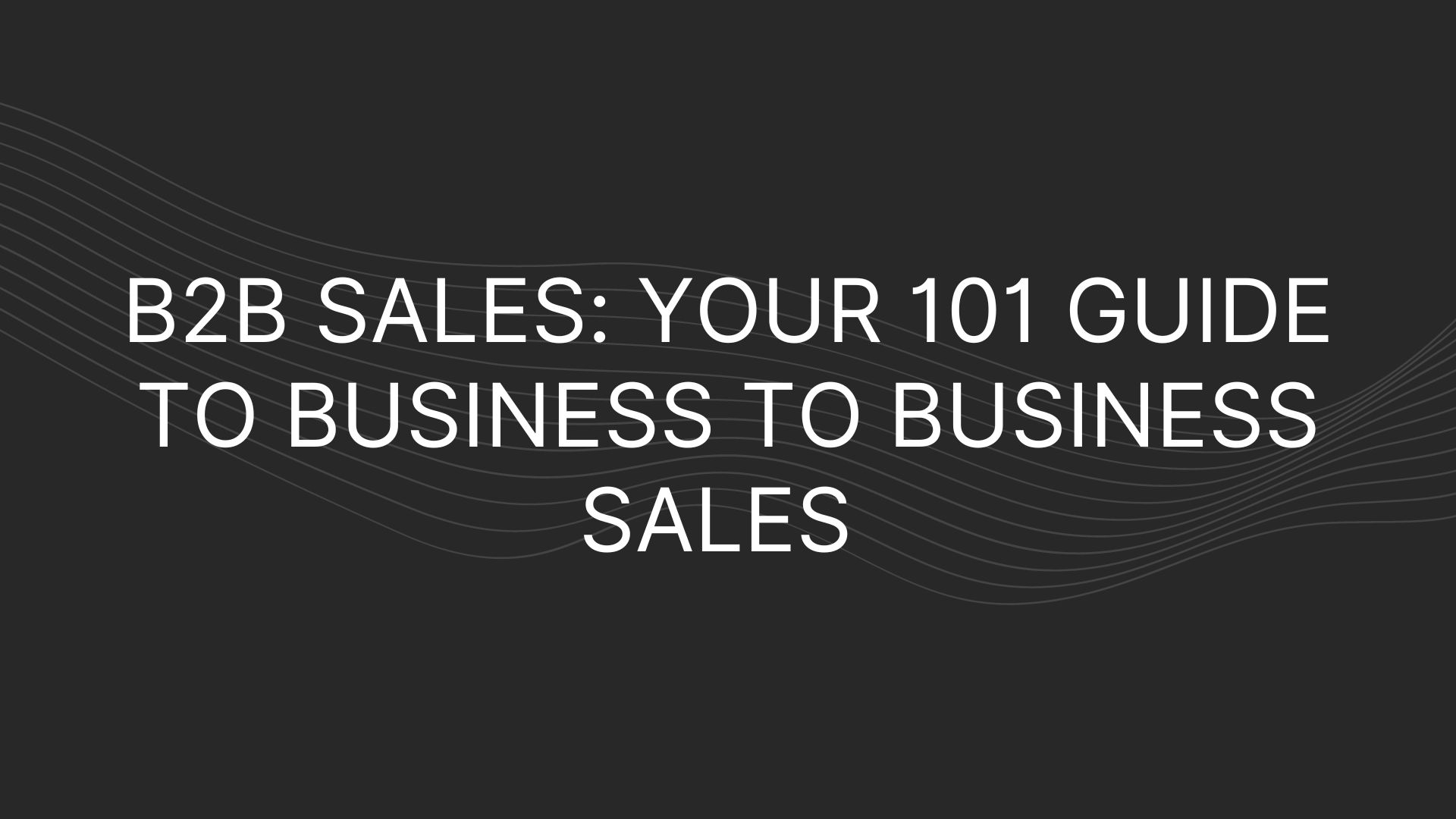B2B sales, or business to business sales, sector has seen tremendous growth over the last two decades. In fact, the B2B sales market is projected to reach $20.9 trillion by 2027.
Still, there are many people who don’t have a clear definition of what B2B sales are, how it works or how it’s different from B2C (business to consumer). Let’s explore the B2B sector and all it has to offer. Read here to see what a B2B sales recruiter can do for you.
What is B2B Sales
B2B sales refer to transactions between two businesses rather than businesses and individual consumers. B2B simply means “business-to-business.”
While transactions are typically larger in the B2B sector, the sales cycle is longer because:
- Multiple stakeholders are involved
- Buyers are more educated, so they weigh their options more carefully
Many types of companies fall into the B2B category.
Examples of B2B Companies
While there are exceptions, business to business sales usually involves one of the following:
Wholesale Or Distribution
Wholesalers sell goods or manufacturing components to other businesses. These may be raw materials or finished products.
Alibaba is a prime example of a wholesale marketplace. They connect retailers with independent wholesalers and distributors who offer everything from toys to household goods, electronics, clothing and more.
Supply
B2B companies that focus on supply sales offer products or consumables that help other businesses run their operations. Companies that offer office equipment and supplies would fall into this category.
In many ways, these B2B companies are very similar to B2C companies. The differences lie in the:
- Size of the transaction
- Purchase authorization
Let’s say that a B2B company sells printer ink. Their customers will likely:
- Order large quantities of ink. The larger the enterprise, the greater the demand for ink.
- Need approval from decision-makers or managers. Typically, B2B purchases like this must be reviewed and approved by leaders.
Quill is a great example of a B2B company that fits into this category. Along with printer ink and paper, they also offer office furniture, cleaning supplies, breakroom supplies, stationery and more.
Service Or Software
B2B businesses that fall into the service/software sales category provide services instead of physical products. Typically, their offerings help businesses:
- Streamline tasks
- Better manage operations
- Boost sales and improve the sales process
- Improve customer satisfaction and management
Many well-known companies fall into this category of B2B sales, including:
- QuickBooks which offers a cloud-based accounting solution for small business owners
- Salesforce offers a suite of software solutions to help businesses manage sales, marketing, workflow and more.
- Asana helps teams collaborate, plan and reach their goals.
- ZoomInfo helps with sales intelligence among many other B2B sales tools
In a nutshell, B2B companies are those that offer products or services that help businesses maintain and grow their operations.
B2B Sales vs B2C Sales
Now that you have a better idea of what B2B sales is, you may be wondering how it differs from B2C.
It’s easy to confuse B2B sales and B2C sales because, at the end of the day, both types of businesses are selling a product or service.
The primary difference between B2B and B2C is this:
- In B2B, a company sells a product or service to another business
- In B2C, a company sells a product or service to an individual consumer for personal use
Examples of business-to-consumer sales include:
- Supermarkets
- Online clothing stores
- Music streaming services
While there may be more consumers than businesses, B2B sales is generally considered better than B2C.
Why B2B Sales are Considered Better than B2C
B2B is considered better than B2C for many reasons, including:
Higher Transactional Value
The sales pipeline may be smaller in the B2B sector (although not always), but the average transactional value is typically much higher compared to B2C.
Consider a multinational corporation with offices across the globe. With a company of this size, an order for something as simple as office supplies can stretch into the tens of thousands of dollars – sometimes more.
The same idea applies to businesses that rely on B2B wholesalers for their raw supplies.
Businesses need more things to run their operations compared to the everyday consumer. For this reason, the quantity and value of their transactions is significantly higher.
Higher Retention
Businesses rely on the products or services offered by B2B companies to keep their operations going. Customer retention tends to be higher in the B2B world.
Companies must make an effort to develop relationships with customers and cultivate loyalty. However, an office is still going to need office supplies, a small business will need an accounting solution, and a manufacturer will need raw materials.
Once a business has established a relationship with a company, they’re more likely to continue doing business with them. Finding a new supplier or service provider means spending time comparing options and potentially interrupting their current workflow.
Sales Cycle Length
Although transactional values and retention rates are generally higher with B2B, the sales cycle length is often much longer than B2C.
That’s because B2B sales:
- Typically involve multiple stakeholders
- Are based on logic rather than emotion (which is common with B2C)
B2B buyers must consider the ROI of the purchase and whether it will solve a real problem.
B2B Products vs B2C Products
B2B products differ from B2C products in that they have different goals (in most cases).
- B2B products aim to help businesses solve real problems.
- B2C products can also solve problems, but they are designed for personal use and to satisfy the individual’s fleeting wants or wishes.
B2B and B2C companies can even sell the same products, but the way in which they are marketed and presented will differ.
Different Segments of B2B Sales
The B2B sector contains three main segments: SMB, mid-market and enterprise.
SMB
SMBs are small-to-medium sized businesses. Small businesses are those with fewer than 100 employees, and medium-sized businesses are those with 100-999 employees.
Small businesses account for 99.9% of all businesses in the United States. There’s no shortage of businesses to market to.
The SMB segment tends to have a shorter sales cycle length because there are fewer people involved in the decision-making process. In many cases, only one person is involved in making purchases, and that is usually the business owner.
That said, the deal size is smaller compared to other segments because small and medium-sized businesses have smaller budgets.
Mid-Market
Mid-market involves selling to businesses that may bring in millions of dollars in revenue each year. These companies are bigger than SMBs, but still below the enterprise level. They typically have revenue of $50 million to $1 billion and have between 100 and 1,000 employees.
Because these companies generate more revenue, they have higher budgets, and the opportunity for revenue is greater.
However, the deal cycle is more complex because more people are involved in the decision-making process.
Enterprise
The enterprise segment is comprised of very large businesses – think Fortune 500. They can bring in significant revenue for B2B companies due to their large budgets. Landing an enterprise customer can also bolster your reputation.
However, deals are far more complex due to the number of people involved in the decision-making process. The sales cycle averages 18 months at the enterprise level.
B2B Sales Stats
Business to business sales is complex, but the industry hit $2 trillion in revenue in 2022. Here are some other impressive stats related to B2B sales:
- 34% of sales reps agree that lead qualification and prospecting are the biggest challenges in B2B sales
- Reps average 18 calls before reaching a B2B buyer
- 30% of a sales rep’s day is spent selling
- 45.6% of B2B buyers want new ideas from sales conversations
- 67% of the buyer’s journey is digital
- 54% of B2B leads are customer referrals
- 1 – 6 months is the average B2B sales cycle
- 2.5m – 3m B2B businesses exist in the US
B2B sales help keep the world running, ensuring that businesses have the best solutions to their problems, learn about new opportunities and can maximize productivity. For more B2B sales stats, we’ve got you covered.
Industry professionals experience a wide range of challenges that must be overcome if they want to find success.
B2B Sales Challenges
Millions of companies exist in the B2B space in the United States alone, leading to immense competition, but there are even more challenges that exist, including:
Competitive Landscape is Huge
B2B sales is big business, with 2.5 million to 3 million companies competing in the space. Generating sales requires diligence and persistence. You need to find ways to connect with buyers, and this often means making over a dozen attempts at contacting the right person.
In the past, you were competing with just other sellers in the United States.
The sales landscape now includes competition worldwide, so you’ll need to react to opportunities rapidly, answer why your product is missing specific features that your competitors have and be willing to hop on a call at a moment’s notice.
Complex Buying Process
Business to business sales can be a complicated process. Selling one item to a customer has little friction in the way of pushback and approvals. In the B2B space, it’s not uncommon for there to be multiple:
- Sales calls and demos
- People who need to approve sales
You’ll also need to identify leads, connect with leads, book appointments with prospects, schedule demos and so much more. The buying cycle is complex and evolving, and it’s critical for sales reps to adapt to make sales.
High Turnover Rate
B2B organizations have a 45% turnover rate, so there’s a chance that the person you’re talking to when trying to nurture a sale will leave the company. If the person leaves before the sale is through, it’s possible that you’ll lose the sale or have to restart the sales process.
Slow Decision-Making
Buyers in the B2B space are often slow decision-makers, causing a potential lag in revenue. Businesses may spend dozens of hours presenting the product, pitching a company and showing them demos, and then the decision needs to go up the ladder.
Customers may be slow to decide on your product, delaying the sale and any commission for sales agents.
Retention is an Ongoing Process
Salespeople make a sale, but that doesn’t mean that their work is done. Customer retention is cheaper than landing a new sale, but it’s still an ongoing process. You need to work on ways to:
- Retain customers
- Improve customer lifetime value
- Stay in contact with customers
If you sell a B2B SaaS solution, memberships may be monthly or annual. You’ll need to convince customers that your solution is the best today and will continue innovating throughout the subscription period.
Sales teams must follow up with sales in this space, ensure that the customer is happy and continue deepening their relationships throughout the years.
Collaboration Between Departments
Collaborating between sales and marketing departments is difficult and complex. Sales leads will need to work closely with marketing reps to ensure that:
- Sales and marketing messages are aligned
- Open lines of communication are kept among teams
If you build a strong line of communication between these two teams, you’ll experience an increase in revenue and retention in the process. Companies that struggle with this should consider hiring a B2B sales consultant or a sales enablement consulting firm.
Benefits of B2B sales
B2B sales offers a lot of benefits to salespeople, including but not limited to:
Deal sizes
Sales in B2B are bigger. You may close fewer deals, but you’ll often make more commission.
Strategic purchases
Purchases are strategic, allowing you to target customers with greater precision.
Less emotional buyers
Buyers are less emotional, and they want the best solution to their problems.
Reliable revenue
Offer a solution that continues to meet the customer’s pain points and solve their problems, and you’ll enjoy long-term, reliable revenue from the customer.
B2B Sales Roles
Sales includes multiple professionals, all working to help the company find success. These job titles include:
Inside, Outside
Inside and outside sales reps communicate with clients either indoors or outdoors, face-to-face, depending on the role.
SDR/BDR
SDRs focus on qualifying inbound leads while their BDR counterparts focus on outbound leads
Sales Development Managers
Professionals responsible for improving and overseeing an organization’s sales department’s SDR’s.
Account Executives
Account execs are responsible for winning new business.
Sales Managers
These professionals oversee one or more sales teams, monitoring their progress and ensuring that they hit their sales goals.
Sales Enablement
Sales enablement managers are esponsible for ensuring sales teams have the resources they need to close more deals.
VP of Sales
Responsible for sales leadership, strategy, and working with B2B sales teams to strengthen sales.
CRO
The CRO is responsible for an organization’s revenue-generating processes, overseeing sales, marketing, and customer success.
B2B Sales Strategies
B2B sales are generated using multiple strategies, including:
- Strategic selling, or a tactic that targets those with the greatest influence in the sales process.
- Solution selling, ridentifying a lead’s challenges and goals and how your solution can best help them.
- Account-based selling, which is one of the most popular strategies. It requires contacting multiple stakeholders in an organization and targeting multiple people at once.
- Social selling is a way to target potential leads on social and building relationships before pushing a sale.
These are just a few of the sales strategies that you can use to make business to business sales.
B2B Sales Process Example
The business to business sales process occurs in multiple stages, including:
- Prospecting: All sales processes start with prospecting. This process involves researching markets, learning who decision-makers are and then trying to reach out to book meetings with them.
- Discovery call: An intro call will be an opportunity to run discovery and allow you to dive deep into the needs of the prospect. You’ll want to take notes and if the conversation is going well, you can move into the demo phase.
- Demo: If there is interest in your service, a demo is in order. You’ll want to showcase how your solution can help solve the pain points of the customer.
- Closing: Finally, the closing takes place. The contract discussion is complete, both parties are happy with the price, and you’ve successfully gone through negotiations to ensure all parties are satisfied.
To conclude, there are many different elements of B2B sales.



